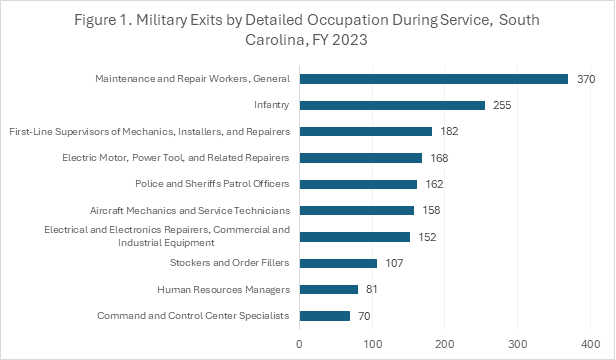From Service Member to Civilian: Examining Military Exits in 2023
By Lainey Stalnaker, Data Analytics Writer

Every year, thousands of members of the U.S. Armed Forces complete their service in South Carolina, and many of them remain in the state and enter the civilian labor force, helping to satisfy demand for skilled workers. Using the JobsEQ tool, [1] DEW can access data on the number of military separatees in the state and their military occupational codes (MOC). Each MOC is then translated into a comparable Standard Occupational Classification (SOC) code to grant insight into the civilian jobs each separatee would be most qualified for. Read on to learn how former service members can transfer their credentials and experience upon leaving the military.
The three most common detailed occupations linked to South Carolina military exits for 2023 (the most recent data available) were “Maintenance and Repair Workers, General” with 370 exits, “Infantry” with 255 exits, and “First Line Supervisors of Mechanics, Installers, and Repairers” with 182 exits. Figure 1 displays the top ten.

Annual demand for an occupation is calculated by adding job growth and separations. When employers expand their operations, they require more staff, and when workers leave a profession, they need to be replaced. Veterans can help to meet this demand by using the skills they gained during service in the civilian labor force.
Figure 2, below, shows selected occupations with at least 15 military exits in 2023 and an exit/demand ratio of at least 10 percent. Occupations with an exit/demand ratio of at least ten percent have the potential to fill one-tenth or more of the new civilian job growth in South Carolina for their skillset. Members of the military can be an invaluable resource for private sector employers seeking experienced workers. For example, “Maintenance and Repair Workers, General” had 370 exits in 2023—equal to 12 percent of annual demand for that same year.
Figure 2. Exit/Demand Ratios of Selected Occupations, South Carolina, FY 2023 | |||
Occupation | Military Exits | Annual Demand | Exit/Demand Ratio |
| Maintenance and Repair Workers, General | 370 | 3,011 | 12% |
| First-Line Supervisors of Mechanics, Installers, and Repairers | 182 | 889 | 20% |
| Police and Sheriffs Patrol Officers | 162 | 1,055 | 15% |
| Human Resources Managers | 81 | 228 | 35% |
| Installation, Maintenance, and Repair Workers, All Other | 58 | 346 | 17% |
| Sailors and Marine Oilers | 35 | 38 | 91% |
| Human Resources Assistants, Except Payroll and Timekeeping | 34 | 130 | 26% |
| Paramedics | 31 | 105 | 29% |
| Information Security Analysts | 28 | 187 | 15% |
| Network and Computer Systems Administrators | 21 | 205 | 10% |
| Air Traffic Controllers | 18 | 19 | 97% |
| Cargo and Freight Agents | 18 | 178 | 10% |
| Engineering Technologists and Technicians, Except Drafters, All Other | 16 | 80 | 20% |
For any veteran who is seeking employment in the civilian workforce, DEW provides a range of resources that can help. Veterans receive priority service at all SC Works Centers, which connect jobseekers to employment opportunities, and the SC Works Veterans Portal provides employment resources that are unique to veterans and transitioning service members. Additionally, the STAYS Program encourages veterans to continue living and working in South Carolina. More information on these resources and others can be accessed through the DEW website.
[1] Source: “Military Exits.” JobsEQ, Chmura Economics and Analytics, FY 2023, jobs-eq.com. Accessed 14 November 2025
